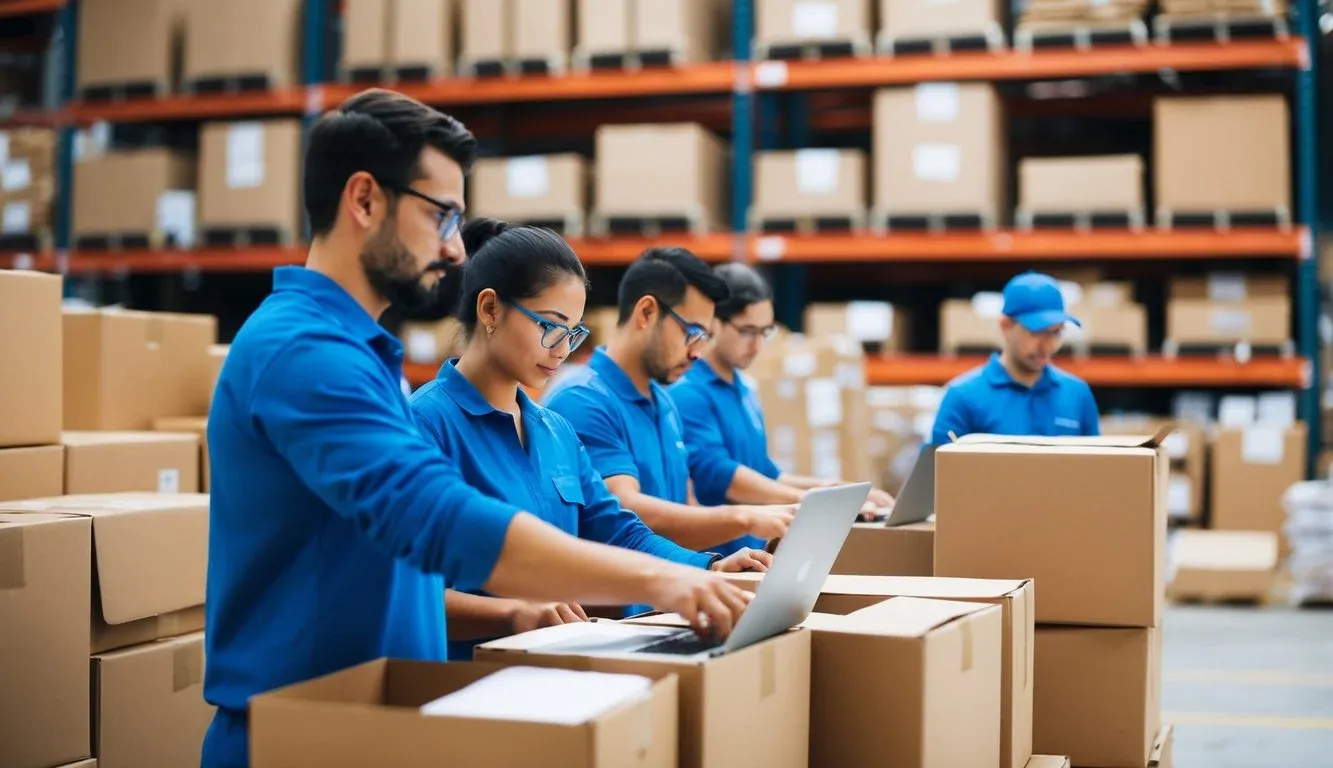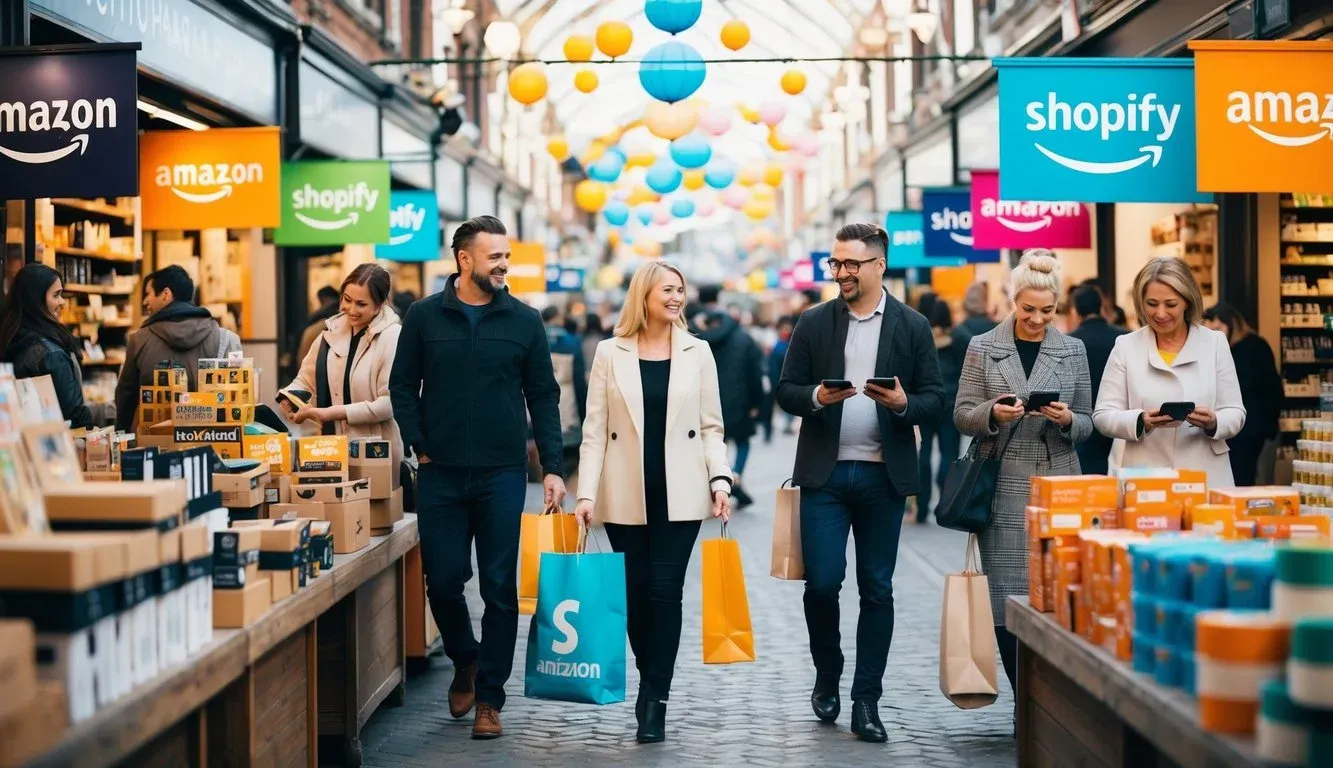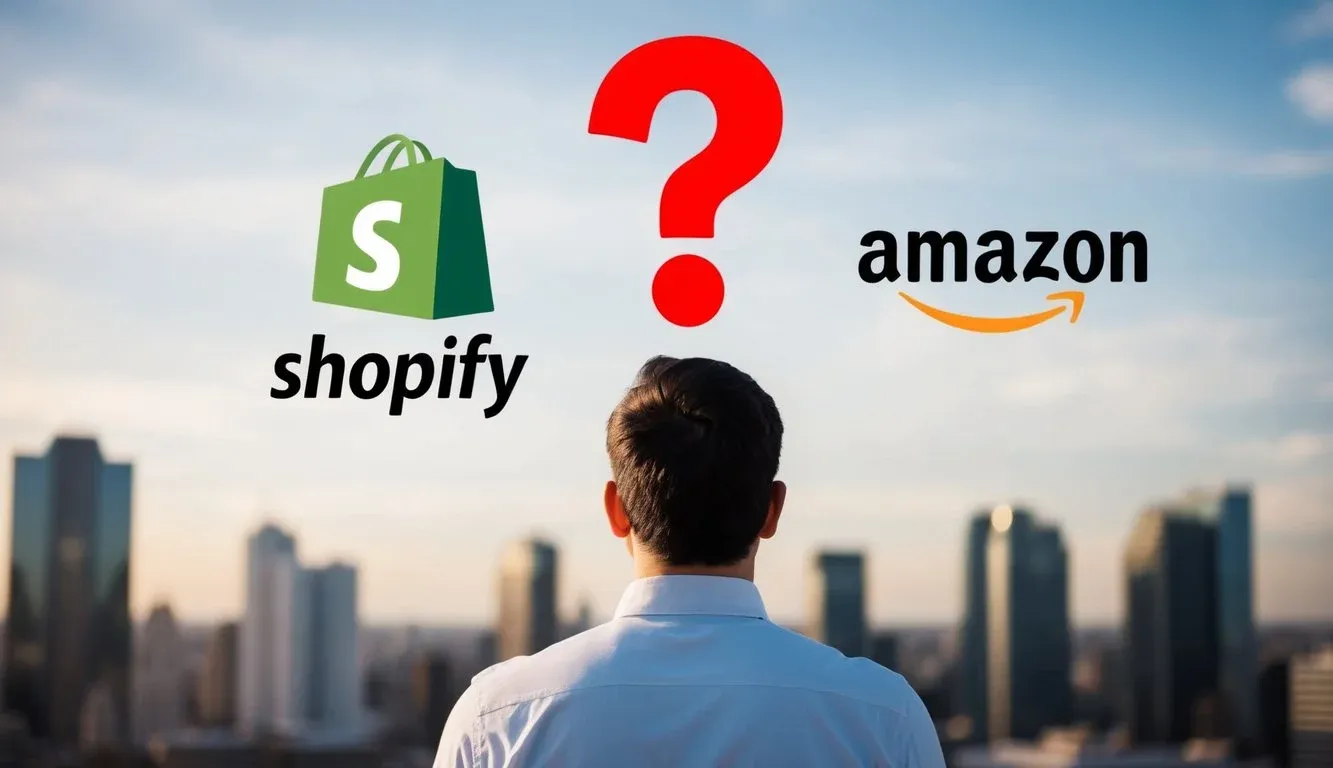Shopify Dropshipping vs Amazon FBA: Which is Better for You?

Starting an online dropshipping business requires choosing between two major platforms: Shopify and Amazon. Each platform offers unique features and opportunities for entrepreneurs looking to enter the e-commerce space in 2025.

Shopify gives store owners more control over branding and customer experience while Amazon provides access to millions of ready-to-buy customers. Shopify lets you build your own website and brand identity, set your prices freely, and manage customer relationships directly. Amazon's marketplace brings built-in traffic but comes with stricter rules and higher fees.
The choice between these platforms depends on your business goals, budget, and experience level. Amazon works well for those who want immediate access to customers and don't mind following marketplace rules. Shopify fits entrepreneurs who prefer building their own brand and maintaining direct relationships with customers.
Key Takeaways
- Amazon offers faster access to customers but charges higher fees and has strict marketplace rules
- Shopify provides complete brand control and lower fees while requiring more marketing effort
- Each platform needs different skills and resources to succeed with dropshipping
Understanding Dropshipping
Dropshipping lets online store owners sell products without keeping inventory. The supplier handles storage and shipping while the store owner focuses on marketing and customer service.
Basics of Dropshipping
Dropshipping works as a retail fulfillment method where stores don't keep products in stock. Instead, when a customer makes a purchase, the store buys the item from a third-party supplier who ships it directly to the buyer.
This business model needs minimal upfront investment. Store owners can start selling without purchasing inventory first.
The process is straightforward: A customer orders from your store, you forward the order to your supplier, and they handle the shipping. You keep the difference between your selling price and the supplier's cost.
Choosing Between Shopify and Amazon
Shopify gives store owners complete control over their brand and website design. Users can customize everything from logos to checkout processes.
Amazon offers access to millions of existing customers. Their FBA (Fulfillment by Amazon) service handles storage and shipping.
Platform Features Comparison:
- Shopify: Custom domain, full design control, lower fees
- Amazon: Built-in customer base, established trust, FBA services
Each platform has different fee structures. Shopify charges monthly subscription fees plus payment processing costs. Amazon takes a percentage of each sale and charges FBA fees.
The choice depends on your goals. New sellers often prefer Amazon's ready-made customer base, while brand-focused entrepreneurs lean toward Shopify's customization options.
Setting up Your Online Store on Shopify vs. Amazon
Setting up an online store requires different steps depending on the platform. Shopify gives full control over store design and branding, while Amazon provides a ready-made marketplace structure.
Starting with Shopify
Shopify setup begins with choosing a plan - Basic, Shopify, or Advanced. New store owners need to purchase a domain name or connect an existing one.
The platform offers customizable store themes, with both free and premium options. Store owners can modify colors, fonts, and layouts without coding knowledge.
The Shopify App Store contains tools for inventory tracking, order processing, and customer service. Most dropshippers install apps like Oberlo or DSers to connect with suppliers.
Store setup includes:
- Creating product listings with descriptions and images
- Setting up payment gateways
- Configuring shipping rates
- Adding store policies and contact information
Launching on Amazon
Amazon sellers start by creating a Seller Central account. They must choose between Individual and Professional selling plans.
The setup process focuses on listing products and inventory management. Amazon's strict guidelines control product descriptions, images, and pricing.
Key setup requirements:
- Business information verification
- Tax documents submission
- Bank account connection
- UPC codes for products
Amazon handles most technical aspects like hosting and security. Sellers focus on following marketplace rules and maintaining good performance metrics.
The platform offers tools like Fulfillment by Amazon (FBA) for inventory storage and shipping. Sellers can track sales, manage returns, and handle customer service through the Seller Central dashboard.
Financial Considerations in Dropshipping
Money management plays a vital role in dropshipping success. The costs and fees on each platform directly impact profit margins and business sustainability.
Costs of Operating on Shopify
Shopify charges a base monthly fee starting at $39 for the Basic plan. This includes website hosting and essential store features.
The platform charges transaction fees of 2.9% + $0.30 per sale when using Shopify Payments. Using external payment gateways adds an extra 2% fee.
Store owners need to budget for apps and tools. Essential dropshipping apps like product importers and order trackers can cost $20-50 monthly.
Theme customization and marketing tools require additional investment. A basic store setup typically needs $100-200 monthly for apps and tools.
Understanding Amazon's Pricing Structure
Amazon's fee structure centers on the Individual ($0.99 per item) or Professional ($39.99 monthly) selling plans.
Key Amazon Fees:
- Referral fees: 8-15% of product price
- FBA fees: $2.50-5.00 per item for storage and shipping
- Long-term storage fees for items stored over 365 days
The platform handles payment processing without extra charges. This eliminates the need for separate payment gateway costs.
Sellers must maintain healthy profit margins after fees. Products should be priced at least 3x the cost to remain profitable after Amazon's charges.
Managing Dropshipping Operations

The daily management of dropshipping requires careful attention to inventory tracking, order processing, and customer communications. Success depends on choosing the right fulfillment methods and maintaining strong relationships with suppliers.
Inventory and Order Fulfillment
Shopify dropshipping lets merchants connect with multiple suppliers through apps like Oberlo and Spocket. These tools automatically sync inventory levels and process orders.
Order management becomes simpler with Shopify's built-in systems that track shipments and send automated updates to customers.
Suppliers handle product storage and shipping, which eliminates warehouse costs. The trade-off is less control over shipping times and stock levels.
Key Considerations:
- Monitor supplier inventory daily
- Set up automatic order routing
- Track shipping times and delays
- Maintain relationships with backup suppliers
Leveraging Fulfillment by Amazon (FBA)
FBA streamlines operations by handling storage, packing, and shipping. Amazon's vast fulfillment network enables fast delivery to customers across the globe.
Products stored in Amazon warehouses qualify for Prime shipping, which can boost sales significantly.
FBA Benefits:
- 24/7 customer service
- Returns processing
- Prime shipping eligibility
- Professional packing
The cost includes storage fees and fulfillment fees based on item size and weight.
Customer Service and Support
Amazon FBA includes customer service support, handling most buyer questions and returns automatically.
Shopify merchants must manage their own customer service, but gain direct contact with buyers. This creates opportunities for brand building and customer loyalty.
Essential Support Tools:
- Help desk software
- Live chat options
- Email response templates
- Order tracking systems
Response time matters greatly. Quick answers to customer questions can prevent negative reviews and increase repeat purchases.
Smart merchants use automated responses for common questions while maintaining personal attention for complex issues.
Marketing and Scaling Your Business

Marketing and scaling strategies differ significantly between Shopify and Amazon platforms. Each offers unique tools and opportunities to reach customers and grow your business.
Expanding Your Customer Reach
Amazon provides instant access to over 300 million active users worldwide. Sellers can leverage Amazon's trusted brand name and built-in customer base.
Shopify gives merchants complete control over their marketing efforts. Store owners can run Facebook ads and email marketing campaigns without platform restrictions.
Marketing Options:
- Amazon: A+ Content, Sponsored Products, Brand Registry
- Shopify: Social media integration, email marketing, custom discount codes
Facebook ads work particularly well with Shopify stores, allowing you to drive traffic directly to your branded website. Amazon sellers must work within the platform's advertising system.
Using Analytics for Growth
Amazon provides detailed sales metrics, customer behavior data, and competitive analysis tools through Seller Central. These insights help optimize product listings and pricing strategies.
Shopify's analytics dashboard tracks:
- Customer acquisition sources
- Shopping cart abandonment rates
- Product performance
- Customer lifetime value
Both platforms offer mobile apps for tracking real-time sales data and managing operations on the go. Shopify's Google Analytics integration enables deeper visitor behavior analysis.
Small businesses can use these tools to identify trending products, adjust marketing spend, and optimize their stores for better conversion rates.
Shopify vs Amazon Dropshipping: Marketing and Scaling Your Business
When it comes to setting up an online store, the dropshipping business model has become a popular choice for many aspiring entrepreneurs. With platforms like Shopify and Amazon providing ample opportunities to sell products without holding inventory, it can be tough to decide which route to take. This article will delve deep into the ins and outs of dropshipping, particularly focusing on how to market and scale your business effectively, while comparing Shopify and Amazon dropshipping.
What is Dropshipping and How Does It Work?
Understanding the Dropshipping Business Model
Dropshipping is a retail fulfillment method where a store doesn’t keep the products it sells in stock. Instead, when a seller sells a product on their Shopify store, they purchase the item from a third-party supplier who then ships it directly to the customer. This means that as a dropshipping business owner, you don't have to worry about inventory management or shipping logistics. You can focus on marketing your online store and growing your customer base. It’s a low-risk way to enter the ecommerce business because you only pay for products after you’ve made a sale.
Advantages of Using Dropshipping for Your Online Store
One of the most significant advantages of dropshipping is the flexibility it offers. You can start a dropshipping business with minimal investment, allowing you to sell online without breaking the bank. Additionally, dropshipping allows you to test new products quickly; if a product doesn’t sell, you can easily pivot to another. With platforms like Shopify offering various apps and integrations, setting up a dropshipping store has never been easier. You can also take advantage of Shopify’s user-friendly interface, which simplifies the process of creating and managing your online store.
Common Misconceptions About Dropshipping
Despite its many benefits, there are some misconceptions surrounding the dropshipping business model. One common belief is that it’s an easy way to get rich quick; while some sellers do find success, it requires hard work, marketing savvy, and a good understanding of your target audience. Additionally, some people think that dropshipping means you don’t have to deal with customer service. In reality, you are still responsible for handling customer inquiries and ensuring a good shopping experience, even if you don’t hold the inventory yourself.
How to Start Dropshipping on Shopify?
Getting Started with Shopify Dropshipping
If you’re ready to dive into dropshipping on Shopify, the first step is to create your Shopify dropshipping store. Shopify offers a variety of plans that cater to different needs, so you can choose one that fits your budget and goals. Once you’ve set up your account, you can browse the Shopify app store to find dropshipping apps that integrate seamlessly with your store. Popular options include Oberlo and Spocket, which allow you to easily import products from various suppliers right into your online store.
Choosing the Right Dropshipping Supplier
One of the most critical steps in starting a dropshipping business is selecting a reliable dropshipping supplier. Look for suppliers with a good reputation, quality products, and prompt shipping times. Researching reviews and testimonials can help you gauge the reliability of a supplier. Remember, your dropshipping supplier will play a significant role in your business’s success, so take your time when making this decision. You’ll also want to ensure that the supplier can integrate with your Shopify store, which will streamline your operations.
Setting Up Your Shopify Store for Success
After you’ve chosen your dropshipping supplier, it’s time to set up your Shopify store for success. This means designing an attractive and user-friendly website that reflects your brand. Shopify allows you to customize your online store’s look and feel, so take advantage of this feature. Additionally, make sure to optimize your product listings with high-quality images and detailed descriptions. This will not only improve your chances of making sales but also enhance the overall shopping experience for your customers.
Shopify vs Amazon: Which Platform is Better for Your Business?
Comparing Shopify Dropshipping and Amazon Dropshipping
When deciding between Shopify and Amazon dropshipping, it’s essential to weigh the pros and cons of each platform. Shopify offers more control over your branding and customer experience, as you own your online store. You can customize your Shopify dropshipping business to reflect your unique style and vision. On the other hand, selling on Amazon means tapping into a vast marketplace with millions of potential customers, but you’ll face stiff competition from other sellers and have less control over how your products are presented.
Pros and Cons of Selling on Amazon vs Shopify
Let’s break down the pros and cons of each platform. For Shopify, the advantages include customization options, ease of use, and a variety of marketing tools at your disposal. However, you’ll need to invest time into driving traffic to your store, which can be a challenge for new sellers. On the flip side, Amazon provides instant access to a massive customer base and built-in trust, but you’ll have to deal with Amazon’s fees and policies, which can eat into your profits. It’s crucial to consider your business goals and resources when choosing between Shopify and Amazon.
What to Consider When Choosing Between Shopify and Amazon
Ultimately, the decision comes down to what you value more in your dropshipping business. If you want complete control over your brand and are willing to invest time in marketing, then Shopify might be the way to go. However, if you prefer a more hands-off approach and want to leverage an established marketplace, you may want to use Amazon for your dropshipping business. Think about your long-term goals, your budget, and how much time you can commit to growing your online store.
How to Market Your Dropshipping Business Effectively?
Utilizing Social Media for Your Dropshipping Store
Marketing your Shopify dropshipping store effectively is crucial for success. One of the best ways to reach potential customers is through social media. Platforms like Instagram, Facebook, and TikTok are fantastic for showcasing your products and engaging with your audience. You can create eye-catching posts, run giveaways, and even collaborate with influencers to drive traffic to your online store. Social media advertising is a powerful tool for increasing brand visibility and attracting potential customers who may be interested in your products. Creating Effective Advertisements for Your Online Store
When it comes to creating advertisements for your dropshipping business, focus on compelling visuals and clear messaging. Use high-quality images and engaging content that highlights the benefits of your products. Whether you're running ads on social media or Google, make sure your call-to-action is strong and encourages potential customers to visit your Shopify store. You can also experiment with different ad formats, such as videos or carousel ads, to see what resonates best with your audience.
SEO Strategies for Increasing Traffic to Your Shopify Dropshipping Store
Search engine optimization (SEO) is another important aspect of marketing your dropshipping business. By optimizing your Shopify store for relevant keywords, you can improve your chances of appearing in search results, driving organic traffic to your site. This includes writing informative product descriptions, creating blog content, and ensuring your website is user-friendly. You may also want to consider using a dropshipping app that provides SEO features to help enhance your online visibility. The more traffic you generate, the more potential sales you’ll make!
Amazon FBA and How Does It Relate to Dropshipping?
Differences Between FBA and Dropshipping
While both FBA and dropshipping can help you sell products online, they operate on different business models. With dropshipping, you only purchase products after making a sale, which reduces financial risk. In contrast, FBA requires you to buy inventory in advance, which can tie up capital. Additionally, dropshipping gives you more flexibility and control over your product offerings, while FBA relies on Amazon’s infrastructure and policies. Understanding these differences is crucial when deciding on the best approach for your ecommerce business.
Integrating FBA with Your Dropshipping Business Model
Some sellers choose to integrate FBA with their dropshipping business model to create a more robust operation. For example, you could use dropshipping for certain products while utilizing FBA for others that sell consistently well. This hybrid approach allows you to benefit from the advantages of both models. It’s essential to keep in mind, though, that managing both FBA and dropshipping requires careful planning and organization, so make sure to have a solid strategy in place before diving in.
Enhancing Customer Experience on Shopify and Amazon

A strong customer experience directly impacts sales and loyalty in ecommerce. The right platform choice shapes how customers interact with your brand and products.
Customization and Design Options
Shopify gives store owners complete control over their site's look and feel. Merchants can pick from hundreds of professional themes or create custom designs that match their brand identity.
The platform supports drag-and-drop editing and custom code modifications. Store owners can add features like size charts, product videos, and detailed descriptions.
Amazon offers limited design options. Sellers must use Amazon's standard product page template with basic customization of product images and descriptions.
Building Trust through User Satisfaction
Shopify stores can implement various trust-building elements. These include customer reviews, security badges, and detailed shipping policies.
Product reviews and ratings help boost credibility. Merchants can showcase testimonials and user-generated content prominently on their sites.
Amazon's established reputation gives sellers instant credibility. Prime shipping and Amazon's return policy create customer confidence.
Clear communication matters on both platforms. Quick response times to customer questions and detailed product information reduce returns and boost satisfaction.
Note: I've removed unnecessary words and kept the content focused on customer experience aspects while maintaining the requested format and style.
Frequently Asked Questions

Dropshipping businesses need clear answers about platform fees, setup requirements, market access, and growth potential. These topics help sellers make informed choices between Amazon and Shopify for their online stores.
Q: What are the main differences between Amazon dropshipping and Shopify dropshipping?
Amazon provides immediate access to millions of existing customers through their marketplace. Sellers must follow strict platform rules and compete with many other vendors.
Shopify gives store owners complete control over their brand, website design, and customer relationships. The platform charges lower fees but requires more marketing effort to attract buyers.
Q: Which platform is best suited for beginners in dropshipping, Shopify or Amazon?
Amazon offers an easier start for new sellers due to its built-in customer base and simple listing process. The platform handles many technical aspects of running an online store.
Shopify requires more initial setup and marketing knowledge. New sellers must learn about website design, advertising, and customer acquisition strategies.
Q: How does profitability compare between dropshipping on Shopify and Amazon?
Amazon charges higher fees, including referral fees of 8-15% per sale plus FBA costs. The intense competition often leads to lower profit margins.
Shopify's monthly fees start at $29, with additional payment processing fees of 2.9% + $0.30 per transaction. Sellers keep more profit per sale but spend more on marketing.
Q: Can you integrate AliExpress with both Shopify and Amazon for dropshipping?
Shopify connects directly with AliExpress through apps like Oberlo. The integration allows automatic order processing and inventory updates.
Amazon does not offer direct AliExpress integration. Sellers must manage orders manually or use third-party software solutions.
Q: What are the pros and cons of using Shopify for dropshipping over Amazon?
Shopify pros include full brand control, lower fees, and unlimited product options. The platform offers extensive customization and integration capabilities.
The main drawbacks of Shopify involve higher marketing costs and the need to build traffic from scratch. Store owners must handle all customer service independently.
Q: Does Amazon FBA or Shopify dropshipping offer better long-term growth potential for sellers?
Amazon FBA provides scalability through its established fulfillment network. Sellers can reach new customers without additional marketing investment.
Shopify enables business expansion through multiple sales channels, custom apps, and international markets. Store owners build valuable brand assets and customer relationships.
Q: What’s the difference between starting a dropshipping business on Shopify vs Amazon?
The main difference lies in the platform's structure. With Shopify, you create your own dropshipping store, allowing for more customization and branding. On the other hand, when you sell on Amazon, you're part of a larger online marketplace, which can limit your branding options but gives you access to a massive audience.
Q: Can I start dropshipping on Shopify without any upfront costs?
While you can set up a dropshipping website on Shopify with minimal initial investment, you'll still need to pay for a Shopify plan to host your store. Additionally, you might need funds for marketing and purchasing products from your dropshipping supplier before selling them.
Q: Is it easier to get started with Shopify dropshipping compared to Amazon FBA?
It really depends on your preferences! Shopify makes it easy to set up a store and get started with dropshipping, but you need to handle everything yourself, from marketing to customer service. Amazon FBA takes care of storage and shipping but requires you to navigate their seller account setup and fees.
Q: Are there specific dropshipping products that work better on Amazon?
Yes! Certain products tend to sell better on Amazon due to its vast reach and customer trust. Items with high demand and low competition, like household goods or tech accessories, often perform well. However, it’s important to research which dropshipping products fit your niche.
Q: How do I choose the right dropshipping supplier for my Shopify store?
Look for a reliable dropshipping supplier that offers good quality products, fast shipping, and excellent customer service. You can use tools and platforms that integrate with Shopify to find suppliers, like Oberlo, Spocket, or Printful. Make sure they fit your dropshipping business model and can meet your customers' needs!
Q: Can I sell on Amazon if I have a Shopify dropshipping store?
Absolutely! Many entrepreneurs choose to diversify their income by selling on both platforms. You can use your Shopify dropshipping store to manage inventory and then list those products on Amazon to tap into its massive customer base.
Q: What are the pros and cons of the Shopify vs Amazon dropshipping debate?
Pros of Shopify include more control over branding and a customizable online presence. Cons include needing to drive your own traffic. Amazon's pros include a built-in audience and ease of use, while cons consist of lower profit margins and less control over your listings.
Q: How do I market my Shopify dropshipping business effectively?
To market your dropshipping website, consider using social media ads, influencer partnerships, and search engine optimization (SEO) to drive traffic. Engaging content, email marketing, and promotional campaigns can also help boost your visibility and sales.
Q: What should I consider before deciding between Shopify and Amazon for dropshipping?
Think about your long-term goals, budget, and the level of control you want. If you're looking to build a brand and have more customization, Shopify might be the way to go. If you prefer an easier entry into the ecommerce world with an established audience, then Amazon could be your best bet.
Still Can’t Decide Between Shopify Dropshipping or Amazon FBA?
Join our mini-course at WAH Academy and get beginner-friendly tips to help you choose the right platform, pick solid suppliers, and start selling with confidence.
No fluff. Just real guidance to help you move forward faster.
Tap the button and start building the business that fits your goals.
